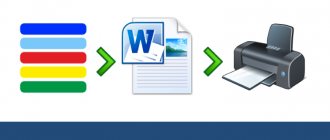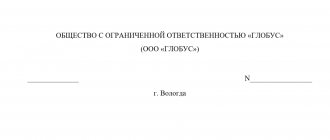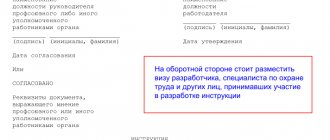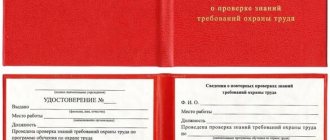On July 1, 2020, a new state standard for document preparation GOST R 7.0.97-2016 “SIBID. Organizational and administrative documentation. Requirements for the preparation of documents" [1] (hereinafter referred to as GOST R 7.0.97-2016). This is an excellent reason to create a local regulatory act (LNA) for the preparation of documents in an organization. In the article, we will look at the sources of information for creating instructions, what sections can be included in it, and also how it can be adapted for ease of use.
Instructions for office work - LNA, which is not included in the list of mandatory internal regulatory documents of the organization (with the exception of government organizations), but its importance is difficult to overestimate. If, of course, the organization monitors its image.
SOURCES FOR CREATING INSTRUCTIONS
When creating instructions for office work, it is advisable to be guided by the following documents:
• Methodological recommendations for the development of instructions for office work in federal executive authorities[2] (hereinafter referred to as MR for federal executive authorities);
• GOST R 7.0.8-2013 “SIBID. Record keeping and archiving. Terms and definitions" (hereinafter referred to as GOST R 7.0.8-2013);
• GOST R 7.0.97-2016.
We recommend using departmental instructions as a sample. For example, the Standard Instructions for office work and archive work in the customs authorities of the Russian Federation[3]. This document can be used as a basis both in content and in the way information is presented.
Types and number of instructions in production
In fact, there is no generally accepted definition of the term production instructions.
Everyone defines it to the extent of their depravity or awareness. Rather, it is a collective image.
So I came to the conclusion that every engineer or other high-ranking official from health and safety comes up with the rules for maintaining documentation himself. We have, in principle, an HSE standard, but it is also not correctly defined in terms of the specific content and number of instructions. There is a list of recommended OT magazines by department. There is also a recommended list regarding technical documentation - there is nothing specific in it either. Based on all this, for some reason OT believes that the number of recommended ones should be at least twice as many instructions and magazines: 80: . I agree that EVERYTHING needs to be written down, presented against signature :shok: . So that later you can say, but we warned you... we told you about this.... and you :fool: - and responsibility has been removed from us == COMPLETE Nonsense == A person is simply not able to “absorb” such an amount of information; it’s not realistic!
I think it is reasonable that the instructions should be brief - generalized and relating only to the narrow specific activities of the worker. Foreman and mechanics must conduct repeated brief instructions directly on the type of daily activities and the main responsibilities of their brigade or service personnel. But all kinds of classes, meetings - a safety hour, conversations on lessons learned from incidents, additional training on civil defense and emergency situations and everything that indirectly concerns workers and for full compliance they must be familiarized - should be carried out by health and safety specialists.
We have already made, at the direction of OT, a list of instructions, the instructions themselves, indicated the points of instructions during briefings (it looks so competent!!!)………. The “inspector” arrived and asked the senior foreman: How many people do you have in your unit???... how long does it take to give each person instructions??? === and when are you engaged in production???......!!! :unknw: ………. The authorities change, new lists, different instructions, we write down a lot of paper again.... The “Senior Auditor” arrives = everything changes again - this needs to be excluded......, added here........, entered here..... and this needs to be taken out....... Brrrrrrrrrrrrrrrrrrrrrrrrrrrrrrrrrrrrrrrrrrrrrrrrrrrrrrrrrrrrrrrrrrrrrrrrr! It turns out infinity!
for pointing out OST 64-02-003-2002 !
but he also approves technological regulations for the production of medicines and their intermediate products... and we seem to be more involved in the engineering and oil industries. If they refer to it they can say that this is not about us……………… Maybe there is something (from the OSTs) that is more specific!? Modified on 06/15/2013 19:50 by Anatoly D.
SECTIONS OF INSTRUCTIONS
When creating instructions, much depends on the principles by which the organization conducts office work. The instructions for a small and a large organization with a wide branch network and a custom-designed electronic document management system will be very different.
We list the sections of the instructions that can be included in the universal instructions (we will assume that electronic documents and their circulation are not alien to the conditional organization):
1. General Provisions.
2. Terms and definitions.
3. Requirements for paperwork.
4. Organization of work with documents.
5. Features of working with electronic documents.
6. Reception, processing, registration and distribution of incoming correspondence.
7. Registration and sending of outgoing documents.
8. Organization of execution of documents and instructions.
9. Features of the preparation and execution of certain types of documents.
The list can be supplemented, for example, with sections “Electronic document management system”, “Features of working with citizens’ appeals”, “Recording and implementation of meeting decisions”, etc. As for archiving, it is better to develop your own LNA for it, because, as a rule, an archive In organizations, only clerks are involved.
Let us present the main recommendations for the content of sections in accordance with the MR for federal executive authorities (Table).
Instructions for office work (documentation support for management) are the main regulatory act regulating the technology of working with documents in an institution: rules, techniques, stages of creating documents, the procedure for working with them, fundamental organizational issues.
Record keeping is one of the typical management functions inherent in each management structure. Any organization, regardless of its organizational and legal form and scale of activity, faces the task of managing resources, financial flows, personnel, etc. Today, office work is considered mainly as a document management activity.
The requirements for the document management system in the Russian Federation are established by the national standard GOST R ISO 15489-1-2007 “System of standards for information, library and publishing. Document management. General requirements", with the introduction of which in our country the document management system is considered as an element of the quality management system. In accordance with this standard, any organization must formulate and document principles of a records management policy. Office management instructions can help create a rational document management system.
Regulatory and methodological basis
Instructions for office work should be based on current legislation in the field of documentation and information and reflect the specific features of working with documents characteristic of a particular organization.
The legal basis for the development of instructions for office work are: legislative and other regulatory legal acts of the Russian Federation in the field of information, documentation and archival affairs; rules of office work in federal executive authorities; methodological recommendations for the development of instructions for office work in federal executive authorities.
The Federal Law “On Information, Informatization and Information Protection” established that documenting information is a prerequisite for including information in information resources, and the documentation procedure is established by government bodies responsible for organizing office work and standardizing documents and their arrays.
In accordance with the Federal Law “On Information, Information Technologies and Information Protection,” the requirement to develop instructions for office work must be observed by executive bodies in the constituent entities of the Russian Federation and local governments. Federal executive authorities, in accordance with the specifics, develop instructions for office work in accordance with the Rules for office work in federal executive authorities.
Other organizations follow this as a best practice, because... the requirement to issue instructions on office management is not necessary for them.
However, to date, the State System of Documentation Support for Management (GSDMOU), adopted in 1988, which regulates paperwork issues, has not been cancelled. The State Budgetary Educational Institution establishes uniform requirements for documenting management activities and organizing work with documents in government bodies, enterprises (associations), institutions and public organizations.
According to clause 1.9 of the State Budgetary Educational Institution, uniform requirements for all documentation systems are implemented by issuing state, republican and industry standards and instructions on documentation support for management activities, taking into account the specifics of the industry.
Authorized bodies have the right to exercise control (supervision) over the activities of legal entities, including the organization of office work. The general procedure for carrying out control is regulated by Federal Law No. 294 of December 26, 2008 and regulations of the relevant authorized bodies. The Federal Archival Agency (its territorial body) has the right to check the organization of office work. One of the objectives of the audit is to monitor the employer’s compliance with the legislation on archival affairs and regulatory legal acts containing mandatory requirements for the organization of office work.
Based on the foregoing, we can conclude that, despite the fact that the law does not regulate the mandatory requirement for drawing up instructions for office work in organizations and institutions of various organizational and legal forms, every manager should be aware of the need for this regulatory and methodological document. In practice, the instruction consolidates the office management system that has developed in a particular organization. Every manager must understand that effective work with information and documentation is possible only when document management activities are organized at a modern level, which is expressed in the normative regulation of technological processes for working with documents.
Who should develop the instructions?
The preparation of the Instructions is carried out by the documentation support service with the participation of the archive and legal services. In organizations that do not have a preschool educational institution service, the development of this document is carried out by the employee responsible for organizing work with documents. The instruction is signed by the head of the department that developed it. The instruction can be put into effect after approval by the head of the organization or after the publication of a special administrative document. An example of an order to introduce instructions for office work is given in Appendix 2.
In both cases, an approval stamp is drawn up on the first page of the instructions indicating the position and date of approval or a link to the administrative document, its date and number. After approval, it is sent to all structural units for use in their work.
Instructions for office work should be communicated to every employee of the organization. The preschool educational institution service must train employees responsible for office work in departments on the new rules for working with documents. In these classes, the developers of the instructions explain the contents of the instructions, paying attention to the most important, fundamental provisions. In the future, the task of the preschool educational institution service is to monitor compliance with the provisions of the instructions in current work.
Requirements for drawing up instructions for office work
When drawing up instructions for paperwork for a specific organization, the Sample instructions for preschool educational institutions given in the VNIIDAD Methodological Recommendations: “Development of normative documents for documentation support of an organization” and sections of GOST R ISO 15489-1 - 2007 “Document Management. General requirements". “Methodological recommendations for the development of instructions for office work in federal executive bodies” can also be used. Although they are mandatory only for state bodies and local governments, nevertheless, the structure and certain general provisions can be used in preparing instructions for office work in organizations of any form of ownership.
Structure of office work instructions
The structure of the text of the instructions for office work is not regulated by normative and methodological documents of intersectoral action. Typically, instructions include general provisions, thematic sections and appendices.
In the “General Provisions” section the following is established:
scope of distribution of the instructions (for example, “the instructions apply to all documents of the organization”, “the instructions apply to all documents except confidential”, etc.); liability for non-compliance; a division that is responsible for a unified procedure for documenting and organizing work with documents in an organization (company) and in structural divisions; regulatory and methodological base.
Thematic sections, as a rule, begin with the section “Rules for the preparation and execution of documents,” which defines: the types and varieties of documents used to document administrative, organizational, and information activities; general rules for the preparation and execution of documents; rules for the preparation of certain types of administrative documents, including the procedure for endorsement, approval, approval and signing;
The section “Organization of document flow and execution of documents” includes several subsections.
The “Registration of Documents” section establishes: the procedure for registering incoming, outgoing and internal documents; terms, forms and methods of registration; rules for indexing documents.
The section of the instructions for office work “Control over the execution of documents” establishes: categories of documents subject to mandatory control; the procedure for putting them under control; control technology (forms of control cards, use of marks on documents, etc.); responsibilities of performers; typical deadlines; the procedure for summarizing data on control over the execution of documents; the procedure for informing managers about performance discipline.
The section “Prompt storage of documents” contains: rules for storing documents in the office management service and in the structural divisions of the organization (company); establishes the responsibility of certain officials for the safety of documents; rules for the formation of certain categories of documents in files; the procedure for developing and using the nomenclature of cases; procedure for systematization and indexing of cases.
The section “Preparation of documents for submission to the archive” includes: the procedure for conducting an examination (selecting documents for storage and destruction); rules for preparing files for storage; requirements for the description and execution of cases; the procedure for transferring cases to the archive.
The composition of thematic sections may be changed and supplemented depending on the working conditions and the adopted technology. The instructions for office work may contain sections on working with citizens' appeals, with documents with a limited scope of distribution (DSP), on technical support for the preparation of documents (printing, sound recording, shorthand, fax, etc.).
The instructions for office work are usually accompanied by appendices, which should contain a maximum of reference and illustrative material, systematized in the order of sections. The annexes include document flow diagrams, seal and stamp impressions, sample forms, samples of filling out document forms, examples of execution of certain types of documents, lists of controlled documents, forms for their accounting, forms of case nomenclature, etc.
Form-sample instructions for office work
An analysis of scientific and methodological literature in the field of office work has shown that today there is no sample form for instructions on office work displaying the full set of details. In this regard, we have developed a model form for the Office Work Instructions with the necessary set of details (see Appendix 1). The sample form we have developed includes a complete set of necessary details, which is what is presented in scientific sources.
The correct execution of instructions for office work is one of the conditions that ensures competent work with documents of any enterprise. Many organizations develop their own individual corporate design style to draw up local regulations.
Let's analyze the instructions for office work of the open joint-stock company Magnitogorsk Iron and Steel Works (hereinafter OJSC MMK) from the point of view of its compliance with the basic requirements and identify what advantages and disadvantages there are in its design. OJSC MMK is not a government agency and therefore develops its own regulatory and methodological framework independently, including instructions for office work. For a comprehensive analysis, the instructions for office work of OJSC MMK I JSC 3-01-2011, Revision No. 12 were taken. The analysis will be carried out on the basis of a sample form developed by us on the basis of the normative and methodological support of federal executive authorities and the practice of enterprises of this organizational and legal form.
By type of activity (purpose) and place in the management documentation system, the analyzed instruction refers to management documentation, in particular, to organizational and legal documentation, because The instruction establishes a unified system of office work and is mandatory for all employees of the institution or company.
Organizational and legal documents contain provisions that are strictly binding; they implement the norms of administrative law and are the legal basis for the activities of the institution. Instructions for office work undergo a mandatory approval procedure by the head of the organization or its collegial body (for example, a meeting of shareholders or the Board of Directors).
Organizational documents can be approved directly by an act of the manager with the approval stamp affixed to the organizational and legal document or by an administrative document (resolution, decision, order or instruction).
The office work instructions do not have a document form code in OKUD, therefore, they are not included in the unified documentation systems. The analyzed document does not have strict unification.
GOST R 6.30-2003 does not include such details as an acquaintance visa. This detail must be included in the Office Work Instructions form, since all employees working with documents must be familiar with the document. [2]
The analyzed office work instructions are drawn up on a blank sheet of paper with a title page. Instructions for office work refer to documents of a complex structure, the design of which differs from other organizational and administrative documents, so the presence of a title page is justified. The instructions have all the necessary details to identify the document, but lack the details identifying the author of the document. The document is drawn up with the details arranged longitudinally.
The format and color of the paper, the font size of the details, line spacing, the spacing between the details, and the size of the fields generally comply with the technical requirements. The instructions for office work are drawn up on standard A4 format documents (210 x 297 (mm)), which is correct. The margins of the analyzed document are also formatted in accordance with GOST R 6.30-2003: 20 mm - left; 10 mm - right; 20 mm - top; 20 mm - bottom.
Compositionally, the design of this office work instruction contains all the parts:
Title page; Content; Application area; Normative references; List of abbreviations;
Main text (the text includes sections “General Requirements” and sections revealing the main content of the text, from No. 5 to No. 10);
Applications.
The title page must contain the details of the general form of the document, the name of the LNA, the approval stamp, and the year of publication. In the analyzed instructions on the title page there are no details: the emblem of the organization, the name of the organization, the stamp of approval, the place of compilation or publication of the document. [14]
The edited cover page for the instructions is presented in Appendix 3.
From a quantitative point of view, the document has most of the necessary details. The absence of a place of preparation and a visa for familiarization weakens the legal and managerial functions of the document. The presence of details of the mark on the execution of the document and its sending to the file, the identifier of the electronic copy of the document is not necessary, because The instructions are valid until replaced with a new one.
Compliance or non-compliance of the registration of details with the requirements of the sample form
Requisite 10 - Name of the type of document - correctly formatted in bold, capital letters, without spacing between letters, which corresponds to the requirements of GOST R 6.30-2003, Figure B. The name of the LNA includes the name of the type of document (Instructions), a heading revealing the contents of the document, constituting one integer with the name of the document. The name performs the search function of the document.
Requisite 11 – Date of the document – in the analyzed instructions it is formatted after the title in an abbreviation in a digital way: the day of the month is one digit instead of two, as prescribed in GOST, the month is two digits, the year is four Arabic numerals. The details are not drawn up in accordance with GOST requirements for their location on the form. The date of the document management instruction is the date of approval of the document. Registration of the date in the analyzed document makes it difficult to understand the date the document entered into legal force. The date recorded is the development date or the approval date. Based on the fact that the date is written together with the abbreviation I AO, which most likely means “instruction of the administrative department,” the date should correspond to the day the instruction entered into administrative force. In general, the design of the date on the title page is acceptable in accordance with the accepted design in the organization.
Props 18 – the title of the text – is grammatically correctly combined with the name of the type of document Instructions. Begins with the preposition “by”, because. This combination is fixed in office practice and briefly reflects the content of the text. The title is formatted correctly with a capital letter, bold font without quotation marks and a period at the end. Performs a search function and is reflected in documents during registration and identifies the document.
Requisite 20 – the text of the document – is drawn up in the state language of the Russian Federation. The text of the analyzed instructions is designed in the form of a coherent text, divided into paragraphs and subparagraphs. The text fully meets the requirements of a neutral tone of presentation.
Details 22 “Signature” include: the title of the position of the person who signed the document (full if the document is not drawn up on the document form); decryption of signature (initials, surname). There is no personal signature, which indicates that this is a draft document.
Requisite 23 - the stamp of approval of the document consists of the word AGREED, the position of the person with whom the document has been agreed upon, decoding the signature (initials, surname). The absence of a handwritten signature and approval date indicates that the document is a draft.
Requisite 12 - registration number - includes a mandatory element - serial number - 12, which must correspond to the entry in the registration log of organizational and legal documents issued. The props are written in the right margin just below the middle of the sheet. This attribute contains the word “Editorial”, which has an additional expansive meaning. Deviation from the requirements for the location of the registration number does not significantly affect the functions performed by the analyzed property and provides the document with search and legal force.
In office work practice, the following rule has been developed: if a document is approved by order, then its date and number are the date and number of the order (in accordance with Regulations dated 02.12.2010 No. 123).
If the LNA is approved directly by the manager, i.e. by putting a handwritten signature on the approval stamp, then such LNA are registered separately and it was customary for them to indicate only the date of their registration (in accordance with the Regulations of 02/12/2010)
It is clear that this approach is inconvenient for systematizing LNA, recording them, and forming a single information resource for LNA. That is why organizations that operate a large volume of LNA, when forming them into a single information array, come to the need to introduce a unified system for recording these documents, in which any LNA, regardless of how it was approved, is assigned an individual registration number.
The registration number, as a rule, includes the serial registration number of the document, to which additional alphabetic or numerical designations may be added, depending on the classification of LNA adopted by the organization.[14]
In the analyzed instructions there is no mark about the performer, which is replaced by the Developer attribute. The DEVELOPER attribute is not provided for by the requirements of the standard, however, information about the developer of a local regulatory act helps to quickly identify the person responsible for the development of instructions.. According to V.F. Yankova, head of the documentation support department of the VNIIDAD management, in addition to information about the persons participating in the document approval procedure, in the approval sheet includes information about the developer (responsible executor) of the LNA. [14] Therefore, the presence of this requisite in the analyzed instructions is justified
Approval for this instruction should be drawn up on a separate sheet. In the document being analyzed, the approval stamp and the approval visa, which are written below the signature, are confused. This design weakens the management function of the document.
Missing attribute 30 - Electronic document identifier. This can make it difficult to find a document in an organization's electronic document catalog.
In the analyzed instructions, we included the details of an acquaintance visa. The organization may keep a log of familiarization with the Instructions, or prepare a familiarization sheet.
In terms of presentation style, the text of the instructions is of a regulatory nature (“established”, “not allowed”, “prohibited”, etc.) The text of the instructions is provided with a neutral tone of presentation. The text is presented in the third person singular or plural, or in impersonal form. For example: “The contractor is obliged to hand over documents completed in office work to the clerk of the structural unit.” Or “Clerks of structural divisions are required to provide monthly data to the office on the volume of document flow.”
The requirements for accuracy, conciseness, clarity, information content, and managerial expediency are met.
The analyzed instructions for office work are a draft document, since there are no handwritten signatures of the developer, the acting head of the administrative department and the approving persons.
An analysis of specific instructions for office work demonstrates the important role of a sample form in the preparation and execution of instructions for office work at an enterprise. The sample form we have developed can be used to develop instructions for office work of any organizational and legal form, which is important for enterprises that are not members of executive authorities.
TEXT OF INSTRUCTIONS
Of course, using the “copy-paste” combination is easiest. You can take whole pieces from GOST, departmental LNA or even from the instructions of friendly organizations. Just don't do this. Whoever, the document developer must know the text of his creation to the last letter. We recommend taking the long route and typing the instructions manually, section by section.
Along the way, the text of the instructions should be provided with examples, explaining, for example, how to fill out the “Name of organization” detail - with the name of your organization, and not some other. In the examples for the “Signature” or “Visa” details, you must show the names of those officials who work in the organization.
In addition, typing instructions manually will help to avoid such misunderstandings as the words “in a state executive body” instead of the words “in the Company”, names and surnames clearly from another, unknown whose, document.
ALGORITHM FOR WORKING ON INSTRUCTIONS
Let us present the algorithm for working on the instructions for office work (Scheme).
The draft instruction is its text, which the secretary submits for approval to officials of the organization. Of course, each organization has its own composition of approving persons for different types of documents, but everyone will most likely study the paperwork instructions: this is the LNA, which will be used in every structural unit, without exception.
The agreed text of the office management instructions is submitted to the General Director for approval.
Putting an instruction into effect is not just about approving it or even distributing it to structural units. It is important to ensure that the instructions are used daily so that they become a useful reference for colleagues.
Types of instructions
In hazardous industries, action guidelines can protect the health and lives of employees. The developed labor protection instructions relate to the operation of units, mechanisms and other industrial equipment.
Instructions on safety and labor protection are created for industries separately. In this case, it is important to rely on the specifics of production. When it comes to construction, the manual includes norms or requirements related to construction projects and the use of machinery at a construction site. For the industry involved in the transportation of goods, they include questions regarding vehicles and transportation of flammable substances.
Not only industry regulations are being created that relate to specific enterprises. The guide to action can also be local, developed for individual workshops. It takes into account certain working conditions, climatic conditions and others. In general, we can say that instructions are divided for specific types of work or positions.
By position and category
Contain techniques for certain categories of employees at the enterprise. A separate document is written for the mechanic or driver. It fits into the algorithm of work performed by a certain employee. This instruction on labor protection is intended for all employees of the enterprise who occupy a similar position.
For the same positions, your own manual can be developed. Everything is defined in the job description for labor protection. One electrician may be busy with traveling work, while another may be busy setting up networks at the enterprise. The operating algorithm will be different, and several instructions are required.
By type of work
Sometimes instructions are associated with certain types of work, or with the use of specific devices in work. It reflects the work:
- on PC;
- for cleaning the workshop;
- with a ladder or stepladder;
- on a machine of various types;
- associated with mowing grass.
Instructions of this kind can always be used by employees who have access to specific work. For example, a cleaning lady is wiping down high shelving. In addition to the cleaning instructions, she will need a regulation for the use of the stepladder. Many instructions can be written for one employee.
HOW TO ADAPT THE INSTRUCTIONS FOR EASIER USE
The office management instructions approved by the director are the result of a huge amount of work, but that’s not all. Now you need to adapt the instructions for use. To do this, the instruction file needs to be modified using MS Word.
Creating navigation
If the headings in the text of the instruction are marked exactly as headings (see the Style in MS Word), and not just highlighted in bold or italics, then the document will be more convenient to use. When you press the Ctrl+F key combination on the left, the Navigation , and the user only needs one click on the title to go to the desired section.
Adding hyperlinks
Hyperlinks in the text, especially to terms and appendices to paragraphs, will significantly simplify the user’s work on the instructions. How much easier it is to click, for example, on the link “Appendix No. 4” and get to Appendix No. 4 (and back - also using a hyperlink) than to search for it throughout the entire text.
Enter full text search
The completed and approved office work instructions must be saved in an unchangeable format. For example, save the MS Word file as PDF. Then full-text search will be available in it, hyperlinks and headings will work.
"PR" FOR FUTURE INSTRUCTIONS
Employees will almost certainly be hostile to the newly introduced instructions on office work: of course, before there were no rules, and now there is a whole volume that everyone still needs to study. Well, this is a completely normal phenomenon: in management language, the adoption of any new corporate law is called an organizational change. Organizational change does not take place in an organization without resistance from employees. The main thing is to remain patient, and after a while they will get used to the instructions and begin to use them. And to make this “some time” come faster, you can use small tricks, for example:
• do not hide from anyone that such a LNA is being developed, and emphasize its necessity at every opportunity;
• focus the attention of colleagues on cases where the lack of approved rules for drawing up documents led to negative consequences: the director did not sign the document, the letter was not accepted for registration in the office of a government agency, an important contract was lost due to incorrect accounting;
• be interested in the opinions of colleagues about the preparation of documents. If someone has suggestions, great, they need to be listened to with special attention. It is not necessary to implement the idea, the main thing is that the author feels that he is also a participant in the work on the instructions - they do not speak badly about their work. By the way, employees often throw in very useful thoughts “from the outside.”
Drawing up and content of labor protection instructions
The instructions include certain sections:
- Requirements necessary before starting work;
- General requirements;
- Measures taken during work;
- Behavior in case of accidents;
- Post-employment requirements.
Any labor safety instruction has its own number and name. It is approved by the employer and discussed with the trade union. The document is signed by the head of the department and agreed with the main specialists of the enterprise.
The document specifies the basic requirements for performing various work processes and using equipment, techniques, methods, and the sequence of performing certain processes. Typically, regulations are written in accessible and specific language, and do not include requirements that are not relevant to the issue and do not include words that can enhance the meaning, such as “strictly” or “categorically.”
General labor protection requirements
These requirements always contain some important points, among them:
- Conditions provided for the admission of workers to activities. This may include gender or age, training received, health;
- Determination of the rules drawn up for the routine within the enterprise;
- Requirements regarding work and rest standards;
- List of harmful production factors affecting employees;
- List of special clothing, protective equipment and footwear;
- Hygiene rules during work;
- The procedure in which the supervisor and administration are notified of an occupational injury.
Compliance with all the requirements listed in the paragraphs will help ensure occupational safety at the proper level.
Before starting work
Each employee must know how to properly prepare their workplace for work and personal protective equipment, which is also prepared in a certain way.
It is important to check the serviceability of work equipment, all tools, important barriers, locking devices, and alarms. The operation of grounding devices, lighting systems, etc. is analyzed. Source materials and manufactured semi-finished products are also checked.
In some cases, instructions are needed for the correct transfer of a shift to an employee when the entire process is ongoing and cannot be stopped.
During work
Employees must be aware of the rules for handling lifting mechanisms, protective equipment and installations so that work is safe.
It is important to properly handle starting materials, workpieces, and primary raw materials. The documentation reflects the rules for proper and safe maintenance of the workplace, as well as measures to prevent various unforeseen situations. It is the responsibility of every employee to know how all protective equipment is applied and when to use it.
In emergency situations
This extensive section describes all kinds of emergency situations, the causes of their occurrence and methods of elimination. Every employee knows how to behave in a given situation, how to avoid negative consequences for their health and the health of their colleagues.
You need to have information about providing assistance to those injured or sick. In any emergency, people know who to contact and who to notify. They know the rules of behavior.
Upon completion of work
It is understood that all appliances must be properly stopped and switched off. They need to be disassembled and lubricated. The same applies to equipment and complex mechanisms.
It is important to observe personal hygiene rules and remove production waste. Management is notified immediately of any difficulties. Employees do this according to established rules.










